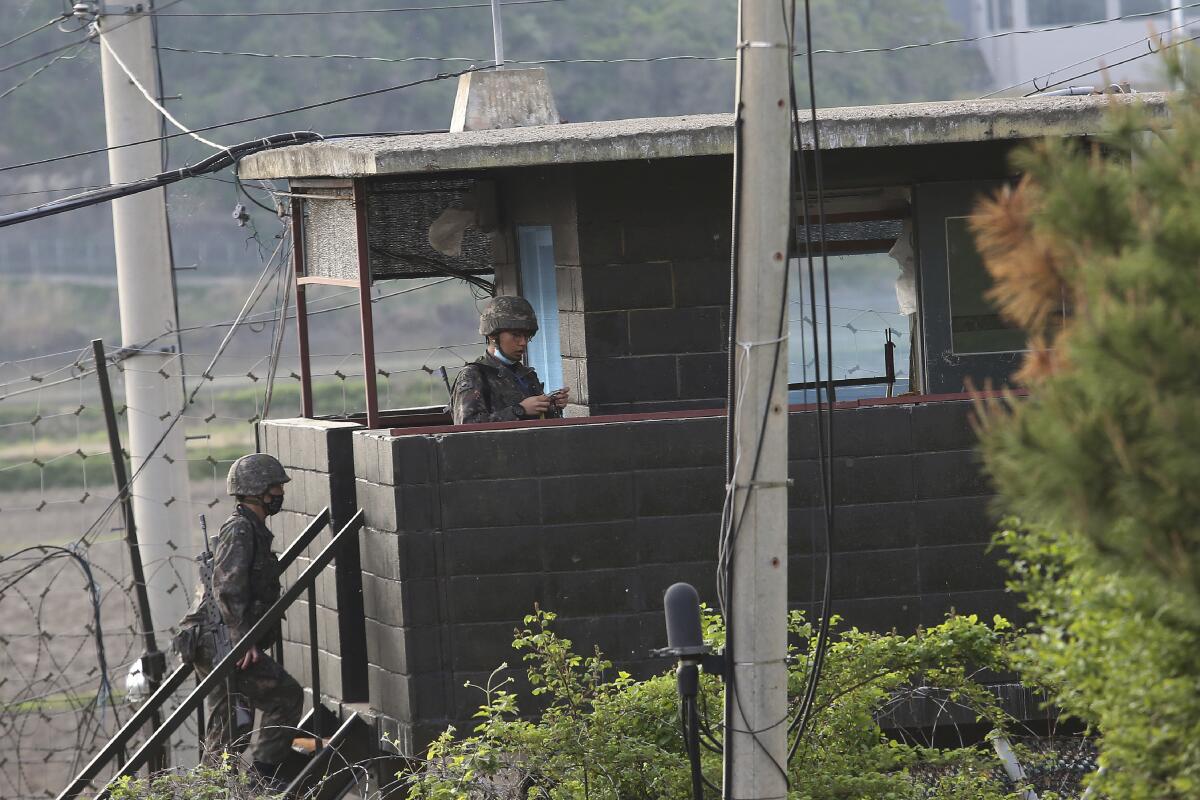Exchange of border fire by North and South Korean troops said not to be deliberate provocation

- Share via
SEOUL — North and South Korean troops exchanged fire along their tense border Sunday, the South’s military said, the first such incident since the rivals took unprecedented steps to lower frontline animosities in late 2018.
Violent confrontations have occasionally occurred along the border, the world’s most heavily fortified. Although Sunday’s incident is a reminder of persistent tensions,there were no known casualties on either side and it is unlikely to escalate, observers said.
The Joint Chiefs of Staff in Seoul said in a statement that North Korean troops fired several bullets at a South Korean guard post inside the border zone. South Korea responded twice with a total of 20 rounds of warning shots before issuing a warning broadcast, it said.
South Korea had no casualties, the military said. Defense officials said it was also unlikely that North Korea had any casualties, because the South Korean warning shots were fired at uninhabited North Korean territory. The North’s state-run Korean Central News Agency did not immediately report the incident.
A preliminary South Korean analysis showed that the shots fired by North Korea were probably not a calculated provocation, though Seoul will continue examining whether there was any motivation for the action, a South Korean defense official said. He spoke on condition of anonymity, citing department rules.
U.S. Secretary of State Michael R. Pompeo also said it was believed that North Korea’s firing was not intentional.
“We think those are accidental,” Pompeo said on ABC’s “This Week.” “South Koreans did return fire. So far as we can tell, there was no loss of life on either side.”
Farming activities around the North Korean area where the shots were fired continued throughout Sunday, and North Korea’s military didn’t display any other suspicious activity after the gunfire, the South Korean defense official said. He said there was thick fog in the area at the time of the incident.
Later Sunday, South Korea sent a message to North Korea to try to avoid an escalation, but the North did not immediately reply, according to South Korea’s military.
The exchange of fire came a day after North Korea broadcast video of its leader, Kim Jong Un, reappearing in public after a 20-day absence amid intense speculation about his health.
The Korean Central News Agency said Kim attended Friday’s ceremony marking the completion of a fertilizer factory near Pyongyang along with senior officials. State TV showed Kim smiling and walking around factory facilities.
Kim earlier vanished from the public eye after presiding over a Politburo meeting of the ruling Workers’ Party on April 11 to discuss the coronavirus. Speculation about his health began swirling after he missed an April 15 event commemorating the birthday of his grandfather and state founder, Kim Il Sung, something he had never done since inheriting power upon his father Kim Jong Il’s death in late 2011.
The Korean peninsula remains split along the 155-mile-long, 2.5-mile-wide border known as the demilitarized zone, or DMZ. It was originally created as a buffer after the 1953 armistice that ended hostilities in the Korean War. About 2 million mines are peppered inside and near the DMZ, which is also guarded by barbed-wire fences, tank traps and combat troops on both sides.
Under a set of agreements to reduce border tensions reached in September 2018, the two Koreas destroyed some of their frontline guard posts and began removing mines from the DMZ later that year. But the efforts stalled amid a deadlock in negotiations between Kim and President Trump meant to persuade North Korea to give up its nuclear arsenal. The diplomacy hasn’t made any headway since the second Kim-Trump summit in Vietnam in early 2019 broke down because of disputes over U.S.-led sanctions on North Korea.
This year, North Korea carried out a slew of short-range missile and other weapons tests, but none posed a direct threat to the U.S. mainland.
The last time gunfire broke out along the Korea border was in November 2017, when North Korean soldiers shot at a colleague fleeing to South Korea. The defector was hit five times but survived. He is now living in South Korea. South Korea didn’t return fire.
Previously, the two Koreas traded gunfire along the DMZ numerous times, but no deadly clashes have occurred in recent years. A 2015 land mine blast that maimed two South Korean soldiers pushed the Koreas to the brink of an armed conflict. South Korea blamed North Korea for the explosion.
More to Read
Sign up for Essential California
The most important California stories and recommendations in your inbox every morning.
You may occasionally receive promotional content from the Los Angeles Times.












